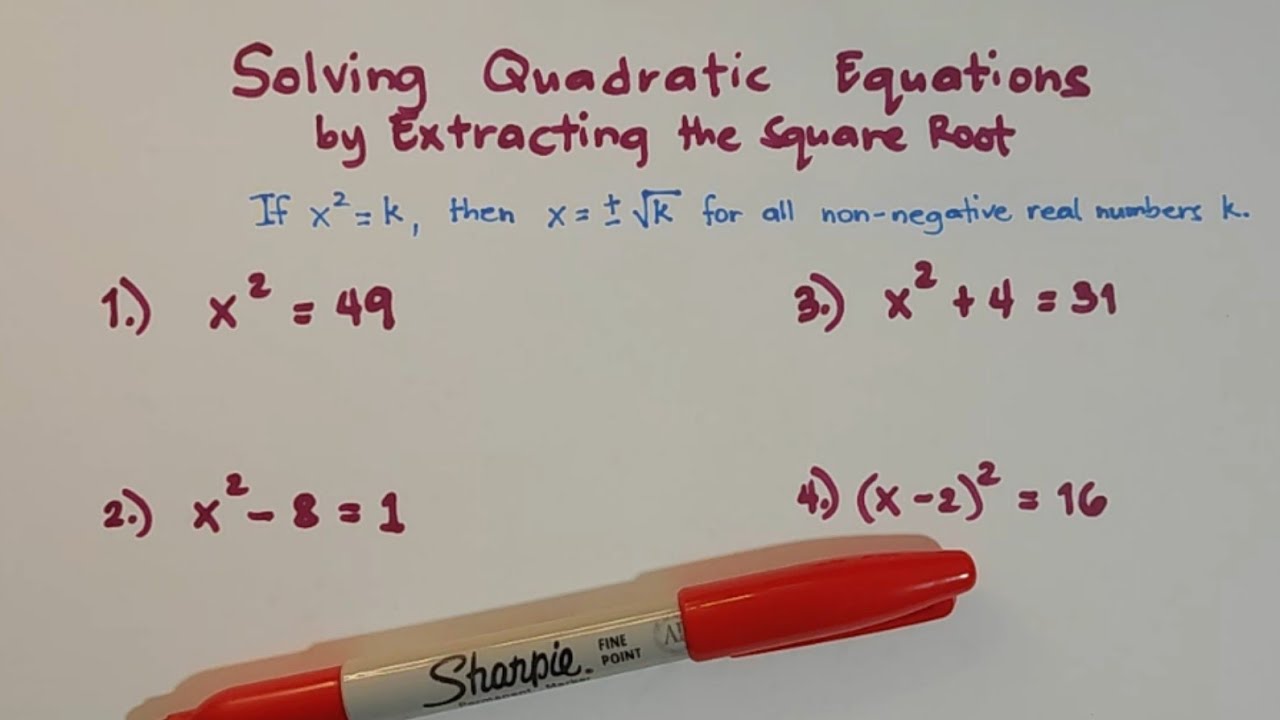Persamaan Kuadrat [Part 2] - Akar Persamaan Kuadrat Metode Memfaktorkan
Summary
TLDRIn this educational video, Pak Beni explains how to find the roots of quadratic equations using factoring methods. He starts by introducing the concept of roots (or solutions) and provides examples to demonstrate how these roots make the equation equal to zero. He further explains the process of factoring quadratic equations step-by-step, showing how to find numbers that multiply to give the product of 'a' and 'c', and add up to 'b'. The video also covers cases where the leading coefficient is greater than one and offers practice problems to reinforce the method. By the end, viewers will be able to confidently apply factoring to solve quadratic equations.
Takeaways
- 😀 The video introduces the concept of solving quadratic equations by factoring.
- 😀 A quadratic equation has two solutions, corresponding to its two roots or factors.
- 😀 The term 'roots' or 'solutions' refers to the values of X that make the equation equal to zero.
- 😀 An example is provided where the equation 'x^2 + 3x - 4 = 0' is solved by factoring.
- 😀 The method of factoring involves breaking down the equation into two binomial factors.
- 😀 The factors of the equation 'x^2 + 3x - 4 = 0' are '(x + 4)' and '(x - 1)', resulting in solutions x = -4 or x = 1.
- 😀 To solve using factoring, one must find two numbers whose product equals ac and whose sum equals b.
- 😀 The video explains how to factor equations with different forms, including when the coefficient of x^2 is greater than 1.
- 😀 A method for solving equations with a coefficient of 2 for x^2 (like '2x^2 + 7x + 3 = 0') is also shown, with a focus on splitting the middle term and simplifying.
- 😀 The process involves rewriting the quadratic equation in factored form, solving for each factor, and finding the roots or solutions.
- 😀 The video concludes by encouraging viewers to practice the steps and stay tuned for the next part of the series on solving quadratics using the quadratic formula.
Q & A
What is the purpose of watching this video?
-The purpose of watching this video is to understand the concept of the roots of quadratic equations and how to determine these roots using the factoring method.
What are 'roots' in the context of quadratic equations?
-In the context of quadratic equations, 'roots' (or solutions) are the values of x that make the equation equal to zero.
How can we find the roots of the quadratic equation x^2 + 3x - 4 = 0?
-To find the roots, we factor the quadratic equation into (x + 4)(x - 1) = 0, which gives the roots as x = -4 and x = 1.
What does 'factoring' a quadratic equation mean?
-Factoring a quadratic equation means rewriting the equation in a product form (like (x + p)(x + q) = 0), where p and q are numbers that satisfy the equation when multiplied and added correctly.
How do you determine the factors for a quadratic equation?
-To determine the factors, you look for two numbers that multiply to give the product of 'a' and 'c' (from the equation ax^2 + bx + c), and that add up to give 'b' (the coefficient of x).
What is the relationship between the coefficients and the factoring process in a quadratic equation?
-The coefficients a, b, and c in the quadratic equation ax^2 + bx + c play a key role in factoring. Specifically, you multiply a and c, then find two numbers that multiply to this product and add up to b.
What happens when the coefficient of x (b) is zero in a quadratic equation?
-When the coefficient of x (b) is zero, the quadratic equation simplifies, and the factoring process becomes easier. For example, the equation x^2 - 9 = 0 can be factored as (x + 3)(x - 3) = 0.
Why is it important to check the roots of the equation after finding them?
-It is important to check the roots to ensure that they satisfy the original equation. This step verifies that the solutions are correct and that they result in zero when substituted back into the equation.
How do you handle equations where the leading coefficient is not 1, such as 2x^2 + 7x + 3 = 0?
-For equations with a leading coefficient other than 1, you follow the same factoring principles, but you may need to adjust the factoring process to account for the larger coefficient. For example, for 2x^2 + 7x + 3 = 0, you would find two numbers that multiply to 6 (2 * 3) and add to 7.
What is the general method to solve a quadratic equation by factoring?
-The general method to solve a quadratic equation by factoring involves: 1) Writing the equation in standard form (ax^2 + bx + c = 0), 2) Finding two numbers that multiply to 'a * c' and add to 'b', 3) Factoring the quadratic into two binomials, and 4) Setting each binomial equal to zero to solve for the roots.
Outlines

此内容仅限付费用户访问。 请升级后访问。
立即升级Mindmap

此内容仅限付费用户访问。 请升级后访问。
立即升级Keywords

此内容仅限付费用户访问。 请升级后访问。
立即升级Highlights

此内容仅限付费用户访问。 请升级后访问。
立即升级Transcripts

此内容仅限付费用户访问。 请升级后访问。
立即升级浏览更多相关视频

Persamaan Kuadrat [Part 5] - Menyusun Persamaan Kuadrat Baru

Mudah Dipahami!!! Pemfaktoran Persamaan Kuadrat

3 Cara mudah akar akar persamaan kuadrat

How to Solve Quadratic Equations by Extracting the Square Root? @MathTeacherGon

Fungsi Kuadrat [Part 6] - Bentuk Umum Fungsi Kuadrat

Uji Pemahaman hal 191 no 2 Matematika Kelas 10
5.0 / 5 (0 votes)
